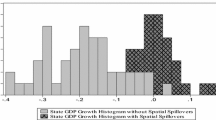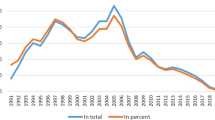Abstract
The purpose of this paper was to examine the strength of the relationship between unemployment and GDP, to determine the extent to which this relationship has been stable in Virginia metropolitan statistical areas (MSA) during the Great Recession and to examine the importance of regional spillovers in Okun’s law. Our results suggest that regional spillovers are very important in local labor markets and in defining the relationship observed at the national level. The MSA level data further supports asymmetries in Okun’s law. The weaker direct relationship between GDP and unemployment at the local level suggests that while federal fiscal and monetary policies to stimulate aggregate demand during periods of economic recovery may be effective, over time, in reducing the unemployment rate, local economic development policies are not effective in achieving the substantial short-term reduction in unemployment needed during recovery. The strong business cycle effects observed in the state MSA, relative to the U.S., suggests that countercyclical policies are fundamentally important and should be targeted more generally to exploit regional spillovers.

Similar content being viewed by others
References
Anselin L (1988) Spatial econometrics: methods and models. Kluwer, Dorddrecht
Apergis N, Rezitis A (2003) An examination of Okun’s law: evidence from regional areas in Greece. Appl Econ 35(10):1147–1151
Ball N, Koenig E (2009) Recent unemployment increases break the law. Federal Reserve Bank of Dallas National Economic Update, June 29. http://dallasfed.org/research/update-us/2009/0904.cfm. Accessed 5 April 2012
Ball L, Leigh D, Loungani P (2013) Okun’s law: fit at fifty?, NBER Working Papers 18668, National Bureau of Economic Research Inc
Binet M, Facchini F (2013) Okun’s law in the french regions: a cross-regional comparison. Econ Bull 33(1):420–433
Blackley P (1991) The measurement and determination of Okun’s law: evidence from state economies. J Macroecon 13(4):641–656
Blanchard O, Summers L (1987) Hysteresis in unemployment. Eur Econ Rev 31(1–2):288–295
Carlino G, Inman R (2013) Local deficits and local jobs: can U.S. states stabilize their own economies? NBER Working Paper No. 18930, National Bureau of Economic Research Inc
Christopoulos D (2004) The relationship between output and unemployment: evidence from Greek regions. Papers Reg Sci 83(3):611–620
Connaughton J, Madsen R (2009) Regional implications of the 2001 recession. Ann Reg Sci 43(2):491–507
Connaughton J, Madsen R (2012) U.S. State and regional economic impact of the 2008/2009 recession. J Reg Anal Policy 42(3): 177–187
Cuaresma J (2003) Okun’s law revisited. Oxf Bull Econ Stat 65(4):439–451
Cuestas J, Gil-Alana L (2011) Unemployment hysteresis, structural changes, non-linearities and fractional integration in European transition economies. Sheffield Economic Research Paper Series, University of Sheffield, UK
Debarsy N, Ertur C, LeSage J (2012) Interpreting dynamic space-time panel data models. Stat Methodol 9(1–2):158–171
Freeman D (2001) Panel tests of Okun’s law for ten industrial countries. Econ Inq 39(4):511–523
Holmes M, Silverstone B (2006) Okun’s law, asymmetries and jobless recoveries in the United States: a Markov-switching approach. Econ Lett 92(2):293–299
Im K, Pesaran M, Shin Y (2003) Testing for unit roots in heterogeneous panels. J Econom 115:53–74
Kangasharju A, Tavera C, Nijkamp P (2012) Regional growth and unemployment: the validity of Okun’s law for the Finnish regions. Spat Econ Anal 7(3):381–395
Knotek E II (2007) How useful is Okun’s law? Economic Review, Federal Reserve Bank of Kansas City, issue Q IV, pp 73–103
Kuscevic C (2012) Okun’s law and urban spillovers. Banco Central de Bolivia, Encuentro de Economistas de Bolivia. http://www.bcb.gob.bo/eeb/sites/default/files/paralelas5eeb/viernes/Macroeconomia%20B/Casto%20Montero.pdf
LeSage J, Pace R (2009) Introduction to spatial econometrics. CRC Press Taylor & Francis Group, Boca Raton
Moosa I (1997) A cross-country comparison of Okun’s coefficient. J Comp Econ 24(3):335–356
Oates W (1972) Fiscal federalism. Harcourt Brace Jovanovich, New York
Oberst C, Oelgemöller J (2013) Economic Growth and Regional Labor Market Development in German Regions: Okun’s Law in a Spatial Context, FCN Working Papers 5/2013, E.ON Energy Research Center, Future Energy Consumer Needs and Behavior (FCN)
Okun A (1962) Potential GNP: its measurement and significance. In: Proceedings of the business and economics statistics section of the American statistical association, pp 98–104
Owyang M, Sekhposyan T (2012) Okun’s law over the business cycle: was the great recession all that different? Fed Reserve Bank St. Louis Rev 94(5):399–418
Owyang M, Piger J, Wall H (2013) Discordant city employment cycles. Reg Sci Urban Econ 43(2):367–384
Pereira R (2013) Okun’s law across the business cycle and during the great recession: a Markov switching analysis. The College of William and Mary Working Paper Series
Perron P (1989) The great crash, the oil price shock, and the unit root hypothesis. Econometrica 57(6):1361–1401
Perugini C (2009) Employment intensity of growth in Italy. A note using regional data. Reg Sect Econ Stud 9(1) 59–105
Silvapulle P, Moosa I, Silvapulle M (2004) Asymmetry in Okun’s law. Can J Econ 37(2):353–374
Thirlwall A (1969) Okun’s law and the natural rate of growth. South Econ J 36:87–89
Villaverde J, Maza A (2009) The robustness of Okun’s law in Spain, 1980–2004: regional evidence. J Policy Model 31(2):289–297
Weber C (1995) Cyclical output, cyclical unemployment and Okun’s coefficient: a new approach. J Appl Econ 10:433–445
Yazgan M, Yilmazkuday H (2009) Okun’s convergence within the US. Lett Spat Res Sci 2(2):109–122
Acknowledgments
This research was developed with support from Virginia Employment Commission. I would also like to thank Tim Kestner, Peter McHenry, Sarah Stafford and the anonymous referees for their very valuable comments and suggestions.
Author information
Authors and Affiliations
Corresponding author
Rights and permissions
About this article
Cite this article
Pereira, R.M. Okun’s law, asymmetries and regional spillovers: evidence from Virginia metropolitan statistical areas and the District of Columbia. Ann Reg Sci 52, 583–595 (2014). https://doi.org/10.1007/s00168-014-0600-x
Received:
Accepted:
Published:
Issue Date:
DOI: https://doi.org/10.1007/s00168-014-0600-x




